Study Studio offers NCERT Solutions for Class 3 Maths Chapter 11 – Jugs and Mugs, designed by experienced teachers and subject experts as per the latest syllabus of NCERT (CBSE). On Study Studio’s official website, you will find all the solutions for the exercise questions given in the textbook. Reference notes for this chapter are also available for extra support, which will help you to revise the complete syllabus and score good marks in your exams. You can practice and verify your answers with NCERT Solutions for Class 3 Maths Chapter 11 – Jugs and Mugs provided by Study Studio. You can prepare for your exams at a pace that suits you. You can also take the help of our teachers if you want to clear any doubt relating to the topic.
Access NCERT Solutions for Class 3 Maths Chapter 11 – Jugs And Mugs
1.
| Less than 1 liter | More than 1 liter |
Bowl | Big cooking pot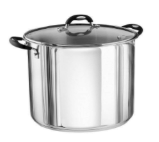 |
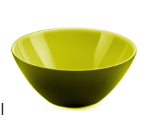
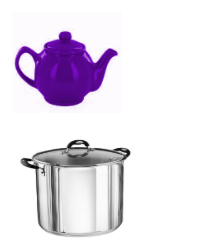
Ans:
| Less than 1 liter | More than 1 liter |
| A small water bottle | A cooker |
| Tetra pack juice | Large bottle of Pepsi |
| A small saucepan | A jug |
The answer may vary from student to student. Because it is based on his/her observation. It is highly recommended that the students prepare the answer on their own observations. The answer provided here is for reference only.
2. Match the Right Pairs
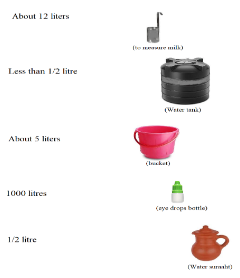
Ans:
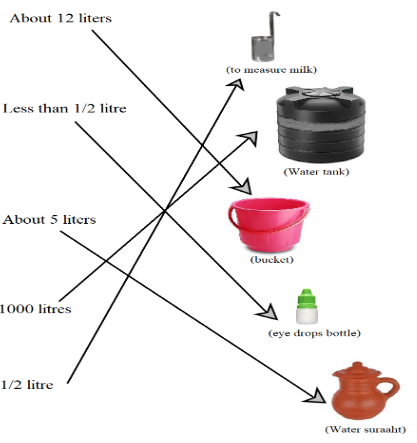
3. Whose Jug Holds More?
a) What are Naima and Jeetu doing?
Ans: Naima and Jeetu are checking the capacity of their jugs and filling their jugs with water. If Naima pours one glass of water in her jug, it looks like this:

b) Naima thinks she will have to pour around 3 glasses of water to fill the jug. What do you think? ____________________
Ans: I think Naima is right. She will have to pour around 3 glasses of water to fill or complete the jug.
If Jeetu pours one glass of water in his jug, it looks like this:
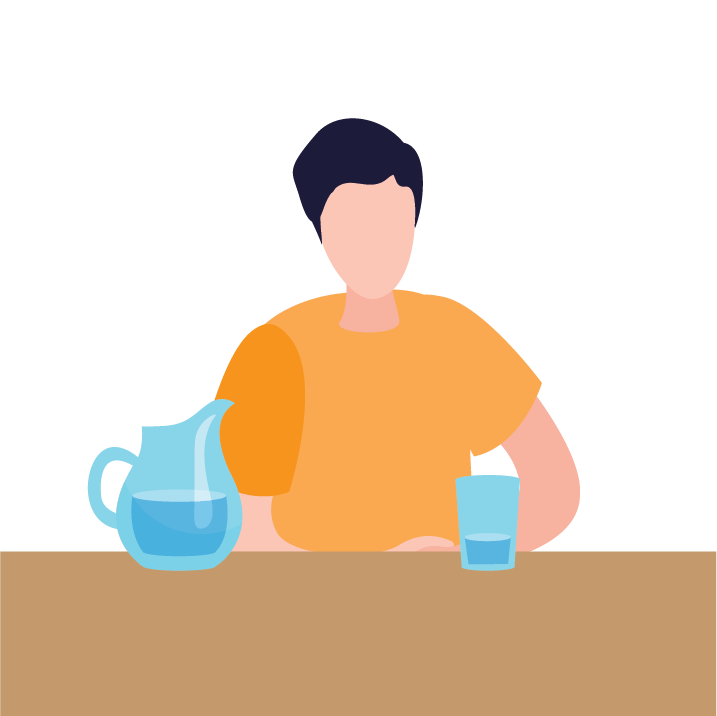
c) Whose jug holds more water? __________________
Ans: Jeetu’s jug holds more water.
d) How many glasses of water do you think Jeetu should pour to fill his jug? __________
Ans: To fill his jug, Jeetu should pour around four glasses of water.
e) If Jeetu pours one more glass of water his jug will be around __________ full.
Ans: If Jeetu pours one more glass of water, his jug will be around half full.
4. Filling Pots
Naseem and Abdul had to fill their pots each with water. Both pots were equally big and heavy. So, they went to the tap again and again, filled their own bottles and poured water into the pots.
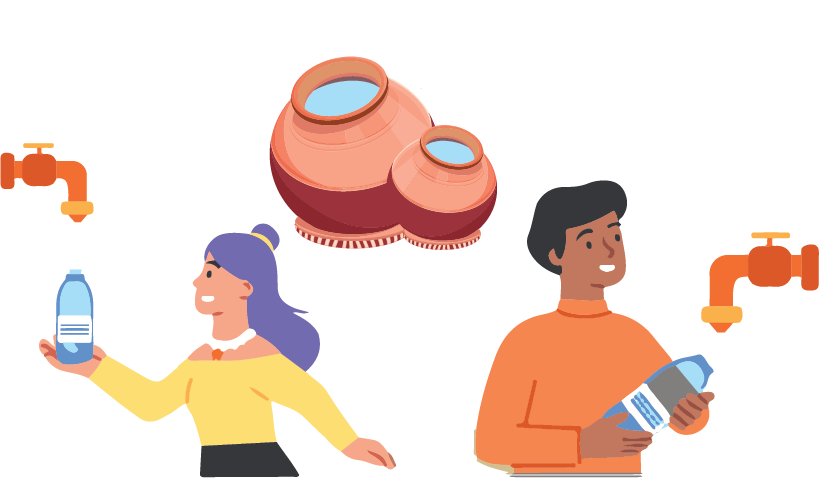
Naseem had to fill her bottle 16 times from the tap. But Abdul had to fill his bottle only 8 times.
a) Why did Naseem go more times than Abdul?
Ans: Naseem had to go more times than Abdul because her bottle is smaller than Abdul’s bottle (On observing as per figure).
b) Naseem’s bottle can hold _____________ (twice/half/three times) as much water as Abdul’s bottle.
Ans: Naseem’s bottle can hold half as much water as Abdul’s bottle.
5. How Many Glasses?
Pot B holds 11 glassfuls of water. Pot A holds twice as much water as pot B.
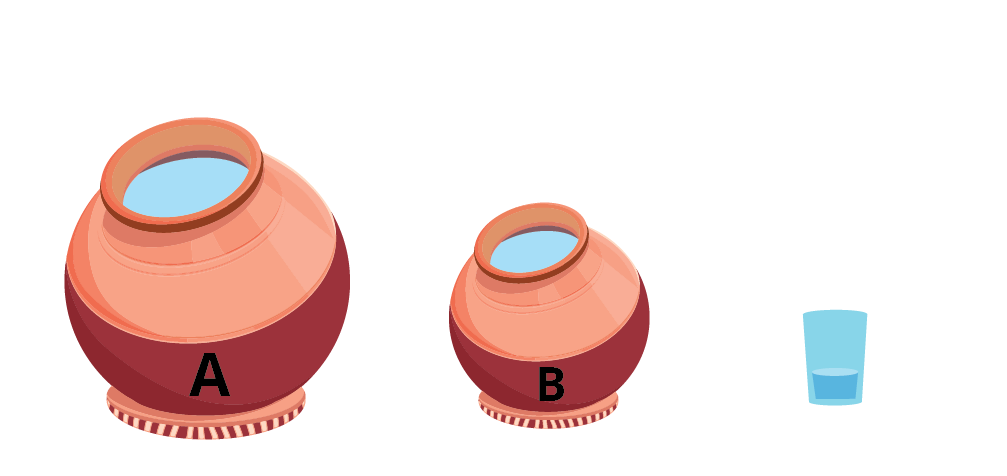
How many glasses of water are needed to fill pot A? _________
Ans:
Given, Pot B can hold 11 glasses of water in it and pot A can hold twice as much water as hold in pot B.
Amount of water pot A can hold
=2×11=22=2×11=22
glasses.
Therefore, pot A can hold 22 glasses of water.
6. Filling Potholes
This is a small town near Kohima. There are some potholes in the road. Before the rains come, children want to fill the holes with pebbles. They bring pebbles in mugs of the same size. Hole A gets filled with 9 mugs of pebbles. Hole B gets filled with 18 mugs of pebbles. Hole C gets filled with 12 mugs of pebbles.
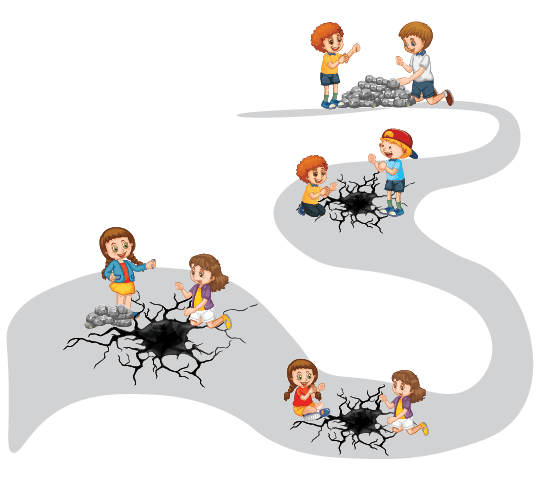
a) Mark A, B, C on the right hole in the picture.
Ans:
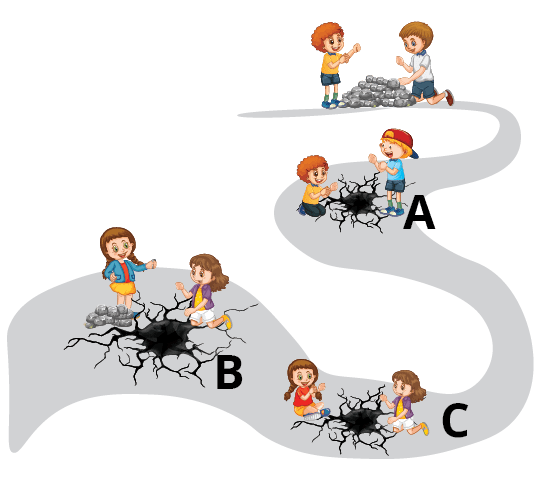
b) Which is the biggest pothole? _____________
Ans: The Biggest pothole is B.
c) If jugs are used, hole A gets filled with 5 jugs. How many jugs of pebbles are needed to fill hole B? ____________
Ans: 9 mugs of pebbles fill the hole A whereas only 5 jugs are required to fill hole A.
⇒⇒
Capacity of 9 mugs
==
capacity of 5 jugs.
So, if we have to fill hole B, then the number of mugs required
=18=9×2=18=9×2
.
So, number of jugs required to fill pothole B
=2×5=10=2×5=10
.
Therefore, 10 jugs are required to fill pothole B.
What is Capacity?
We learn about volume and capacity in NCERT Solutions for Class 3 Maths Chapter 11 – Jugs and Mugs. In this lesson, we learn about the measurement of liquids in the form of a story. There is a wedding in Bunny’s family and he has invited many guests to the party. This funny story tells us about measuring liquid. Let us quickly check the basics of the measurements before solving the questions.
The quantity of a liquid such as water, milk or juice etc. is called its volume. Capacity is the amount of any liquid that a container can hold. We measure volumes of liquids such as water, milk, juice, petrol or kerosene with a container whose capacity we know.
The standard units of capacity are litre and millilitre.
1000 millilitres (ml) = 1 litre ( l )
Half of 1 litre (l) = 500 ml
- A millilitre is a very small unit of capacity. For example, the capacity of a teaspoon is about 5 ml.
- A litre is a bigger unit of capacity. For example, the capacity of your water bottle is about 1l.
Big containers will hold more liquid. This means the capacity of the container is big. Small containers will hold less liquid. This means that the capacity of the container is small. Example: A pot will hold more water. A glass will hold less water.
We need measuring containers to measure liquid. Do you see the picture below? This is called a measuring jug. We use this jug to measure any kind of liquid. Do you see the markings on the jug? These markings tell us how much water or liquid we need.
(image will be uploaded soon)
Let us see how we use this in real-life applications through examples.
Jaggu and Bunny had to fill two pots of the same size with juice. Jaggu had a small bottle and Bunny had a big bottle. Jaggu had to fill his bottle 10 times whereas Bunny filled his bottle 5 times only in order to fill the pots. Why do you think so?
This is because Jaggu’s bottle was half the size of Bunny’s bottle.
Conclusion
So what did we learn today? We learnt the measurement of liquid in terms of volume and capacity. We need measuring containers to measure the volume of the liquid. There are many different measuring containers available. You must have seen your mother using measuring containers while cooking.
This lesson is very helpful in our daily activities. We can measure and drink water every day. We should have at least 2l of water every day to keep ourselves healthy. Whenever you offer juice or cold drinks to your friends, you can use the measuring container. This will give you a correct picture of the quantity of the juice.